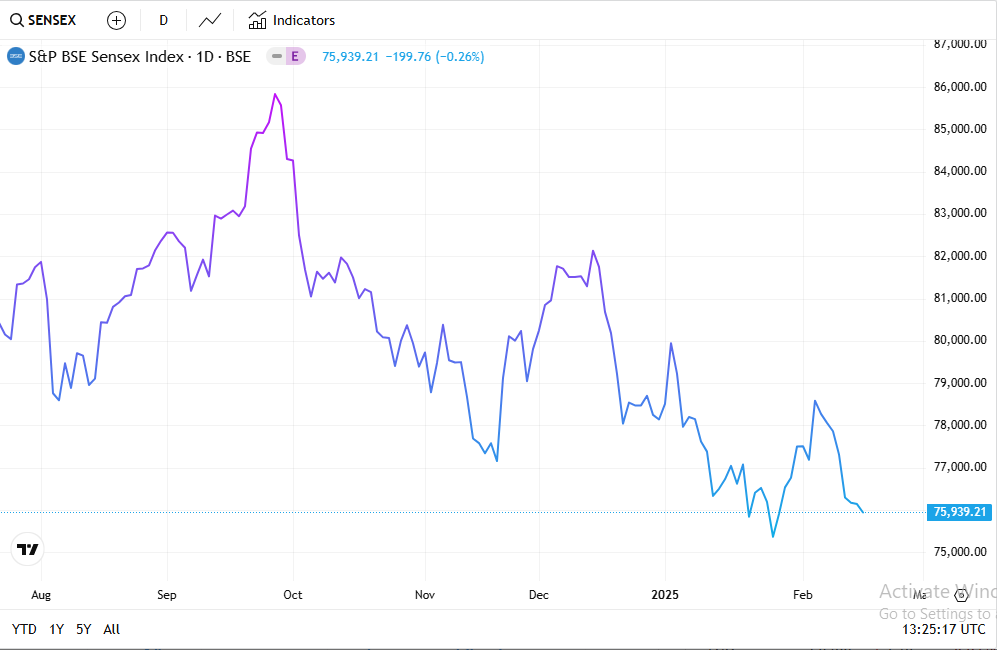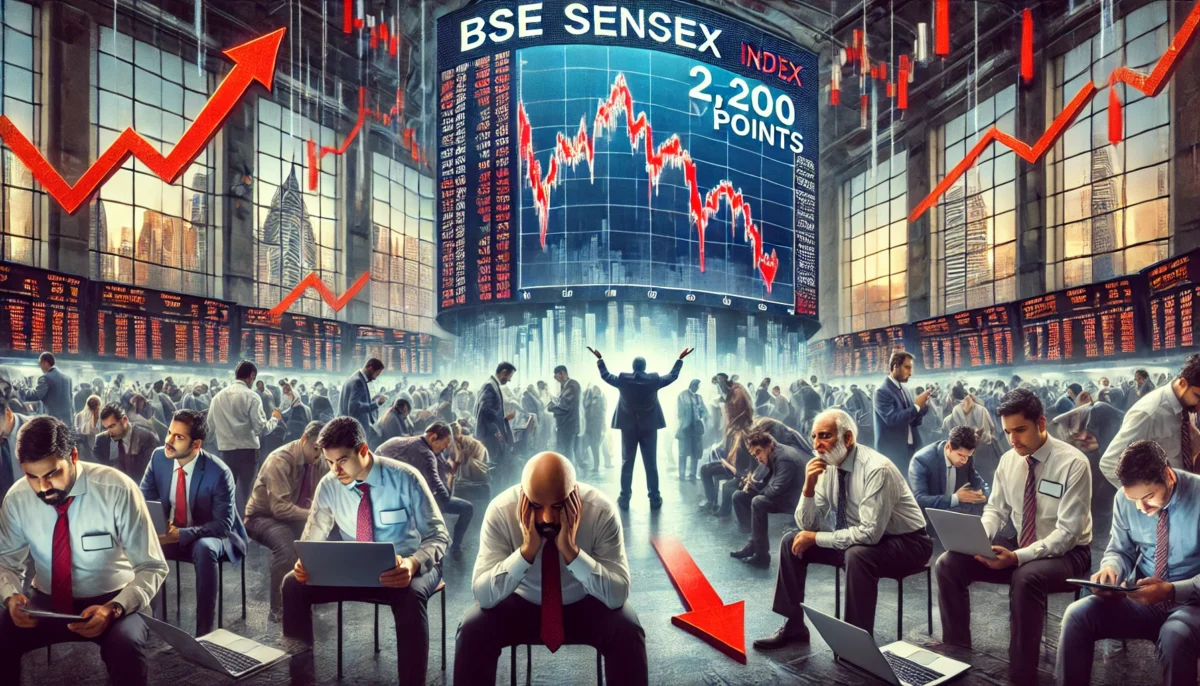Is This a Market Crash or a Buy-the-Dip Opportunity?
Hey there, fellow investors! If you’ve been tracking the stock market lately, you might be feeling a little uneasy. The BSE SENSEX—India’s most important stock index—has taken a significant hit, dropping 2,200 points, or 2.82%, since the beginning of 2025.

The Big Question:
Should you be worried and exit the market?
Or is this actually a golden opportunity to invest at lower levels?
The answer isn’t straightforward. But understanding why this happened can help us make better investment decisions.
So, let’s break it all down in a simple, fun, and conversational way (because we all know stock market jargon can be confusing).
In this article, we will discuss:
✅ The reasons behind the market drop
✅ How different sectors are reacting
✅ What history tells us about market corrections
✅ What investors should do next
First, Let’s Understand the Numbers
Before we jump into the reasons behind the market fall, let’s get our facts straight.
What’s happening in the Indian stock market?
The BSE SENSEX has fallen by 2,200 points (or 2.82%) since January 2025.
In September 2024, it reached an all-time high of 85,978.25 points.
The overall sentiment is bearish, but not all sectors are struggling.
Foreign investors have started pulling out their money, putting additional pressure on the market.
Sounds concerning, right?
But wait! Stock markets don’t move randomly. There are always factors influencing them, and once we understand them, we can make informed decisions.
So, what’s really happening? Let’s take a closer look.
1. The Global Trade War: US Tariffs on India & Its Impact on Stocks
One of the biggest reasons behind the recent stock market fall is global trade tensions, particularly between India and the United States.
Even though Indian Prime Minister Narendra Modi and US President Donald Trump (yes, he’s back in power!) have had several diplomatic meetings, investors remain cautious about new trade tariffs.
Why are US tariffs bad for Indian stocks?
🔹 Higher tariffs make Indian exports more expensive, reducing their demand in the US.
🔹 Pharmaceuticals, textiles, and IT sectors will suffer the most, as they rely heavily on US markets.
🔹 Lower demand for Indian exports will impact corporate earnings, leading to weaker stock prices.
🔹 Foreign investors react negatively to uncertainty, often pulling out money from Indian stocks.
In short, global trade tensions create uncertainty, and markets hate uncertainty.
2. RBI, Interest Rates & Inflation: A Balancing Act
The Reserve Bank of India (RBI) plays a crucial role in shaping the stock market by controlling interest rates and inflation.
Current RBI policy scenario:
RBI’s interest rate: 6.25% (recently cut from 6.50%)
Inflation: 4.31% (lower than last month’s 5.22%)
Now, let’s break this down in simple terms:
🔹 When interest rates are low, borrowing becomes cheaper, businesses expand, and stock prices generally rise.
🔹 When inflation is high, RBI might stop cutting interest rates or even increase them, slowing down economic growth.
🔹 If inflation keeps rising, RBI may raise rates, making loans expensive and slowing corporate growth.
That’s why the stock market reacts sharply to every inflation report—because it tells investors what RBI might do next.
3. Market Corrections Are Normal: A Look at History
Here’s something most investors forget: Stock market corrections are completely normal.
Historically, markets go through cycles—they rise, correct, and then rise again.
Let’s look at some past examples:
March 2020 (COVID Crash):
- SENSEX crashed by 38%, but recovered within a year and went on to hit new highs.
December 2018:
- Market fell 14%, but rebounded strongly in 2019.
January 2008 (Global Financial Crisis):
- Markets crashed 50%, but fully recovered over the next few years.
The Key Takeaway?
Short-term dips don’t matter if you’re a long-term investor.
Every time the market corrects, it eventually bounces back higher.
This means panic selling is one of the biggest mistakes investors make.
4. Which Sectors Are Struggling vs. Thriving?
Not all stocks are down—some are still holding strong!
Sectors Facing the Biggest Declines:
❌ Pharmaceuticals:
- Sun Pharma (-2.63%)
- Dr. Reddy’s (-2.17%)
❌ Banks & Financial Services:
- Kotak Mahindra Bank (-1.03%)
- Axis Bank (-1.06%)
❌ Infrastructure & Cement:
- UltraTech Cement (-2.45%)
These sectors are facing trouble due to US tariffs, economic slowdown fears, and lower foreign investment.
Sectors That Are Still Holding Strong:
✅ IT & Tech:
- Infosys (+0.71%)
- TCS (+0.63%)
✅ Telecom:
- Bharti Airtel (+0.14%)
✅ Consumer Goods:
- Nestlé India (+0.84%)
These sectors are doing well because domestic demand remains strong, and global digitization continues to support IT stocks.
What Should Investors Do?
If you’re a short-term trader…
🔸 Expect more volatility in the coming weeks.
🔸 If you’re uncomfortable with risk, you might rebalance your portfolio.
🔸 Avoid panic selling—most downturns recover quickly.
If you’re a long-term investor…
✅ This is a great opportunity to buy quality stocks at a discount.
✅ Focus on companies with strong fundamentals (low debt, consistent profits, and growth potential).
✅ Remember: Corrections are temporary, but long-term growth is permanent.
The Final Verdict: Should You Worry About the SENSEX Drop?
No, This is NOT the End of the Bull Market!
Every investor, new or seasoned, has experienced that unsettling moment when they see the SENSEX plunging by hundreds or even thousands of points in a single session. Right now, we’re facing one such moment—a 2,200-point drop in the SENSEX since the beginning of 2025. The question that naturally follows is:
Should you be worried? Should you sell off your holdings? Or is this a golden opportunity to invest more?
Let’s break it down logically, analyze the market behavior, and see why this correction might just be a bump in the road rather than the start of a major market meltdown.
The 2,200-Point Drop: A Temporary Setback or a Market Crash?
The SENSEX, which tracks 30 of India’s largest and most influential companies, has witnessed its fair share of ups and downs over the years. Yes, a 2.82% drop since the start of 2025 sounds scary, but historical data suggests that market corrections are a normal part of long-term growth.
🔹 Fact Check: The SENSEX hit an all-time high of 85,978.25 in September 2024. That means that even with the recent dip, we are still significantly above the market levels from just a few years ago.
🔹 Perspective: In 2008, during the global financial crisis, the SENSEX plunged more than 50% within a year. Yet, by 2010, it had rebounded spectacularly. Those who held onto their investments, or even bought more during the dip, saw massive gains in the following years.
🔹 The Pattern: Every major fall in the SENSEX has been followed by a strong recovery. The same trend played out after the COVID-19 crash in 2020 when the index briefly plummeted below 26,000 but soared past 50,000 within a year.
So, while 2,200 points sounds dramatic, in the grand scheme of things, it might just be another healthy correction before the next big rally.
India’s Economic Growth: A Major Factor Supporting the SENSEX
One of the strongest reasons to stay invested in the stock market despite temporary declines is India’s robust economic growth.
The country is projected to maintain one of the highest GDP growth rates in the world, supported by factors like:
✔️ Rising Domestic Consumption – With a booming middle class and increasing consumer spending, Indian businesses continue to thrive, directly benefiting the SENSEX.
✔️ Government Reforms & Investments – Large-scale infrastructure projects, digital transformation initiatives, and policy reforms such as Make in India and PLI schemes are providing a strong foundation for future growth.
✔️ Global Shifts Favoring India – As companies look to reduce dependence on China, India is becoming a preferred investment destination for global manufacturers. This is evident from the surging FDI inflows in recent years.
With such strong economic underpinnings, a temporary correction in the SENSEX does not change India’s long-term growth trajectory.
Interest Rates & Inflation: A Game-Changer for the Market
Another crucial factor that will determine SENSEX’s future movement is interest rates and inflation.
🔹 The US Federal Reserve’s monetary policy influences capital flows into emerging markets like India. If US interest rates remain high, foreign investors might withdraw funds, putting short-term pressure on the SENSEX.
🔹 However, India’s own interest rate cuts could stimulate economic activity and encourage businesses to expand, boosting stock prices in the long run.
🔹 Inflation in India is moderating, meaning that the RBI might ease monetary policy, making borrowing cheaper and supporting market sentiment.
This creates a mixed scenario where short-term volatility is expected, but long-term growth remains intact.
Don’t Panic! Stay Invested & Use the Dip Wisely
If history has taught us anything, it’s this: panic selling is the worst mistake an investor can make. SENSEX has always bounced back from corrections, often rewarding those who held on or invested more during market dips.
Here’s what smart investors should do right now:
💡 Stay Invested – Selling in a panic often leads to regret later. The market rewards patience.
💡 Diversify Your Portfolio – If you’re holding only high-risk stocks, consider adding some stable blue-chip companies or index funds to balance your portfolio.
💡 Buy the Dip – Some of the best stocks are currently available at a discount. If you have long-term goals, this could be a great time to accumulate quality stocks.
💡 Follow Sectoral Trends – Some sectors, like pharmaceuticals, IT, and consumer goods, tend to be more resilient during market downturns. Consider adding them to your portfolio.
So, what do you think? Will the market bounce back soon, or is this just the beginning of a bigger downturn? Drop your thoughts in the comments!

